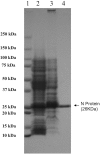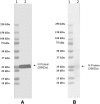Comparison of enzyme-linked immunosorbent assay systems using rift valley fever virus nucleocapsid protein and inactivated virus as antigens
- PMID: 30466469
- PMCID: PMC6249750
- DOI: 10.1186/s12985-018-1071-y
Comparison of enzyme-linked immunosorbent assay systems using rift valley fever virus nucleocapsid protein and inactivated virus as antigens
Abstract
Background: Rift Valley Fever (RVF) is a mosquito-borne viral zoonosis. To detect RVF virus (RVFV) infection, indirect immunoglobulin G (IgG) and immunoglobulin M (IgM) enzyme linked immunosorbent assays (ELISAs) which utilize recombinant RVFV nucleocapsid (RVFV-N) protein as assay antigen, have reportedly been used, however, there is still a need to develop more sensitive and specific methods of detection.
Methods: RVFV-N protein was expressed in Escherichia coli (E. coli) and purified by histidine-tag based affinity chromatography. This recombinant RVFV-N (rRVFV-N) protein was then used as antigen to develop an IgG sandwich ELISA and IgM capture ELISAs for human sera. Ninety six serum samples collected from healthy volunteers during the RVF surveillance programme in Kenya in 2013, and 93 serum samples collected from RVF-suspected patients during the 2006-2007 RVF outbreak in Kenya were used respectively, to evaluate the newly established rRVFV-N protein-based IgG sandwich ELISA and IgM capture ELISA systems in comparison with the inactivated virus-based ELISA systems.
Results: rRVFV-N protein-based-IgG sandwich ELISA and IgM capture ELISA for human sera were established. Both the new ELISA systems were in 100% concordance with the inactivated virus-based ELISA systems, with a sensitivity and specificity of 100%.
Conclusions: Recombinant RVFV-N is a safe and affordable antigen for RVF diagnosis. Our rRVFV-N-based ELISA systems are safe and reliable tools for diagnosis of RVFV infection in humans and especially useful in large-scale epidemiological investigation and for application in developing countries.
Keywords: Expression; IgG sandwich ELISA; IgM capture ELISA; Nucleocapsid protein; RVFV.
Conflict of interest statement
Ethics approval and consent to participate
This research was approved by the Institutional Review Board at the Kenya Medical Research Institute, Kenya (SSC PROTOCOL NO.1698). All experiments were performed in accordance with approved guidelines and regulations.
Consent for publication
Not applicable.
Competing interests
Authors declare no conflict of interest including any financial, personal or other relationships with other people or organization that could inappropriately influence, or be perceived to influence the work.
Publisher’s Note
Springer Nature remains neutral with regard to jurisdictional claims in published maps and institutional affiliations.
Figures




Similar articles
-
Monoclonal Antibodies for Rift Valley Fever Virus Nucleocapsid: Application in IgG/IgM ELISA for Sero-Diagnosis.Pathogens. 2024 Jul 13;13(7):582. doi: 10.3390/pathogens13070582. Pathogens. 2024. PMID: 39057809 Free PMC article.
-
Preparation and evaluation of a recombinant Rift Valley fever virus N protein for the detection of IgG and IgM antibodies in humans and animals by indirect ELISA.J Virol Methods. 2007 Mar;140(1-2):106-14. doi: 10.1016/j.jviromet.2006.11.005. Epub 2006 Dec 15. J Virol Methods. 2007. PMID: 17174410
-
Large-Scale International Validation of an Indirect ELISA Based on Recombinant Nucleocapsid Protein of Rift Valley Fever Virus for the Detection of IgG Antibody in Domestic Ruminants.Viruses. 2021 Aug 19;13(8):1651. doi: 10.3390/v13081651. Viruses. 2021. PMID: 34452515 Free PMC article.
-
Rift Valley fever virus: A review of diagnosis and vaccination, and implications for emergence in Europe.Vaccine. 2015 Oct 13;33(42):5520-5531. doi: 10.1016/j.vaccine.2015.08.020. Epub 2015 Aug 19. Vaccine. 2015. PMID: 26296499 Review.
-
Single-cycle replicable Rift Valley fever virus mutants as safe vaccine candidates.Virus Res. 2016 May 2;216:55-65. doi: 10.1016/j.virusres.2015.05.012. Epub 2015 May 27. Virus Res. 2016. PMID: 26022573 Free PMC article. Review.
Cited by
-
Development and Evaluation of Quantitative Immunoglobulin G Enzyme-Linked Immunosorbent Assay for the Diagnosis of Coronavirus Disease 2019 Using Truncated Recombinant Nucleocapsid Protein as Assay Antigen.Int J Environ Res Public Health. 2021 Sep 13;18(18):9630. doi: 10.3390/ijerph18189630. Int J Environ Res Public Health. 2021. PMID: 34574555 Free PMC article.
-
IgG antibody titers against SARS-CoV-2 nucleocapsid protein correlate with the severity of COVID-19 patients.BMC Microbiol. 2021 Dec 18;21(1):351. doi: 10.1186/s12866-021-02401-0. BMC Microbiol. 2021. PMID: 34922455 Free PMC article.
-
Monoclonal Antibodies for Rift Valley Fever Virus Nucleocapsid: Application in IgG/IgM ELISA for Sero-Diagnosis.Pathogens. 2024 Jul 13;13(7):582. doi: 10.3390/pathogens13070582. Pathogens. 2024. PMID: 39057809 Free PMC article.
-
Recent advances in treatment and detection of Rift Valley fever virus: a comprehensive overview.Virus Genes. 2025 Aug;61(4):400-411. doi: 10.1007/s11262-025-02164-0. Epub 2025 May 10. Virus Genes. 2025. PMID: 40348846 Review.
-
Further Characterization of Rio Grande Virus and Potential for Cross Reactivity with Rift Valley Fever Virus Assays.Viruses. 2021 Aug 30;13(9):1719. doi: 10.3390/v13091719. Viruses. 2021. PMID: 34578299 Free PMC article.
References
-
- Daubney R, Hudson JR, Garnham PC. Enzootic hepatitis or Rift Valley fever. An undescribed virus disease of sheep, cattle and humans from East Africa. J Pathol Bacteriol. 1931;34:545–579. doi: 10.1002/path.1700340418. - DOI
-
- Woods CW, Karpati AM, Grein T, Mc Carthy N, Gaturuku P, Muchiri E, Dunster L, Henderson A, Kahn AS, Swanepoel R, Bonmarin I, Martin L, Mann P, Smoak BL, Ryan M, Ksiazek TG, Arthur RR, Ndikuyeze A, Agata NN, Peters CJ, World Health Organization Hemorrhagic Fever Task Force An outbreak of Rift Valley fever in northeastern Kenya, 1997–1998. Emerg Infect Dis. 2002;8:138–144. doi: 10.3201/eid0802.010023. - DOI - PMC - PubMed
-
- Madani TA, Al-Mazrou YY, Al-Jeffri MH, Mishkhas AA, Al-Rabeah AM, Turkistani AM, Al-Sayed MO, Abodahish AA, Kahn AS, Ksiazek TG, Shobokshi O. Rift Valley fever epidemic in Saudi Arabia: epidemiological, clinical, and laboratory characteristics. Clin Infect Dis. 2003;37:1084–1092. doi: 10.1086/378747. - DOI - PubMed
Publication types
MeSH terms
Substances
LinkOut - more resources
Full Text Sources

